Charger Xtar SP1
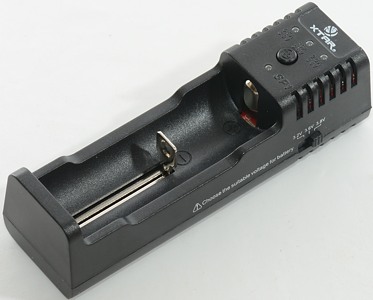
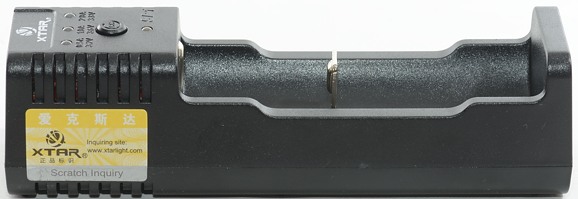
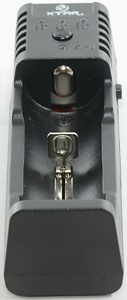
Xtar makes many good chargers, this one is a single channel charger with 3 currents, 3 voltages and able to handle batteries up to 26650 size. This makes it useable for most LiIon batteries on the market, except the smaller ones.
It does also have a usb output, making it possible to charge a phone or other usb equipment from it.
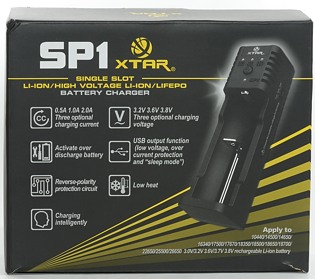
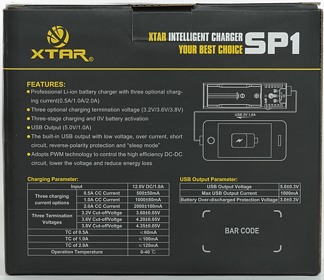
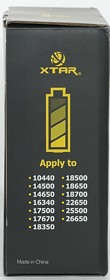
The charger comes in a cardboard box with lots of specifications and batteries sizes listed on it.
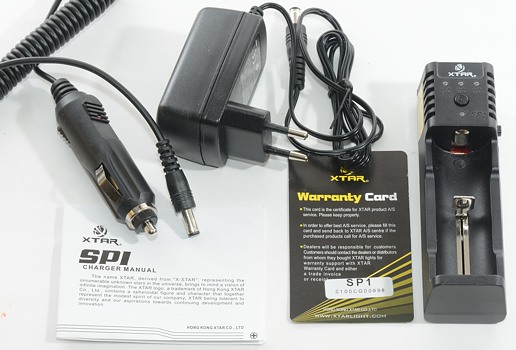
In the box is the charger, a power supply, a car adapter, a warranty card and a manual.
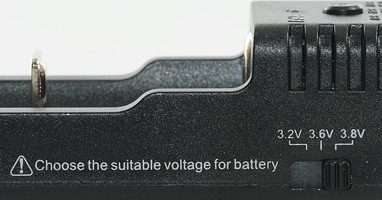
The charger has a switch that can select between 3 voltages, the marked voltages are supposed to be battery nominal voltages. It is very important to select the correct voltage, before starting a charge (See table below).
The actual selection is also shown on the 3 blue leds on top of the charger, before it starts charging and if the switch is moved during charging.
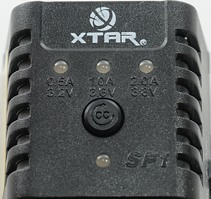
On top of the charger is 4 leds and a button:
3 blue to show selected current and voltage.
1 red/green led.
The button is used to select charge current.
Without a battery in the charger the led for the selected voltage will flash. With a battery in the charger the led for the voltage will flash 3 times, if the voltage is changed.
While charging the led for the selected current will be steadily lit.
The button will step between the 3 current each time it is pressed. Without a battery in the charger the led for the current will be stable lit for a short time, before returning to the flashing voltage display. When charging the next led will just turn on.
It is easy to use, just be aware that the current selection button always is active.
I am not that happy with the markings, they are difficult to read, but when you know the charger they are easy to guess.
The red/green led is red while charging, green at other times, except when using usb output there it is used to signal charge state.
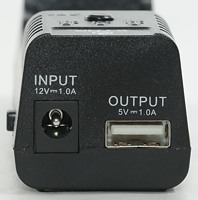
The charger has a 12 volt input and a usb output.
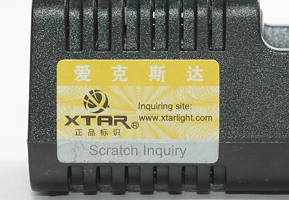
The label with a hidden code to prevent fake chargers is also present.
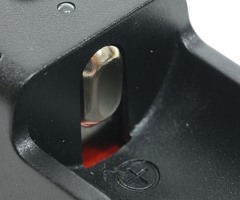
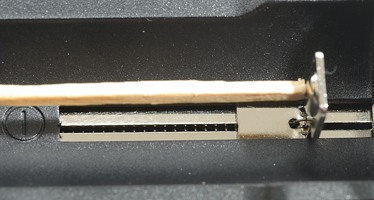
The charger can handle 33 mm to 72 mm long batteries both flat and button top. The slider works fine.









The charger can easily handle 70 mm long batteries including flat top cells.
The charge current is to high for 10440 batteries, except for IMR types.
Measurements
- When turned on the selected voltage will flash a couple of times.
- Below 2 volt the charger will charge with 1.5 to 2 mA, this is independent of selected charge voltage.
- Between 2 and 2.9 volt the charger charges with about 60 mA, this is independent of selected charge voltage.
- Above 2.9 volt regular charge current is applied (See curves below).
- LiFePO4 (3.2V setting) will restart charging when voltage drops to 3.3 volt.
- LiCoO2 (3.6V & 3.8V setting) will restart charging when voltage drops to 3.9 volt.
- The charger will restart charging when power is cycled or battery reinserted.
- When charger is disconnected from power, with a battery in, it will draw up to 9mA from the battery (This is a bit high).
- When charger is connected to power and the main charge is finished, it will charge with 0.3mA for 3.6V & 3.8V setting and 0.7mA for 3.2V setting.
3.6V setting LiCoO2, i.e. 4.2 volt charging voltage
.png)
The 0.5A charge is a very good CC/CV charge with a termination current about 65mA.
.png)
Even my old 16340 cell is handed perfect.
.png)
.png)
Other small cells .
.png)
The 1A charge is also a very good CC/CV charge with a termination current about 70mA.
.png)
.png)
Charge time varies with cell capacity (As usual).
.png)
Using 1A on this old cell also works fine.
.png)
Same with this cell.
.png)
The 2A charge follows the 0.5A and 1A curves in being a very good CC/CV charge, the termination current is about 95mA. The voltage curve is slight more rounded, due to resistance in the charger and the temperature is higher, due to the higher current.
.png)
Using an external 12 volt supply show that the charger need about 500mA on 12 volt to deliver 1A to the battery.
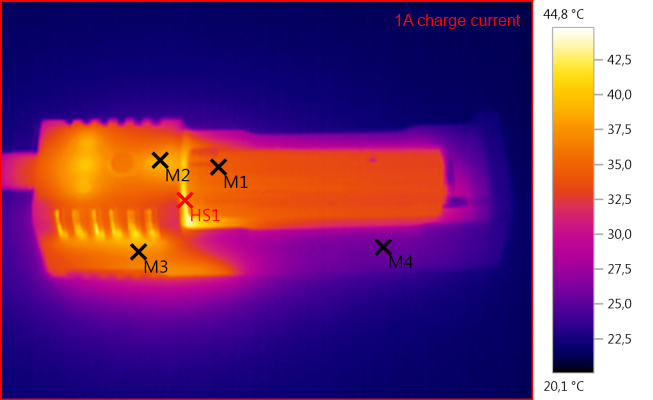
M1: 34,4°C, M2: 38,7°C, M3: 37,1°C, M4: 25,8°C, HS1: 44,8°C
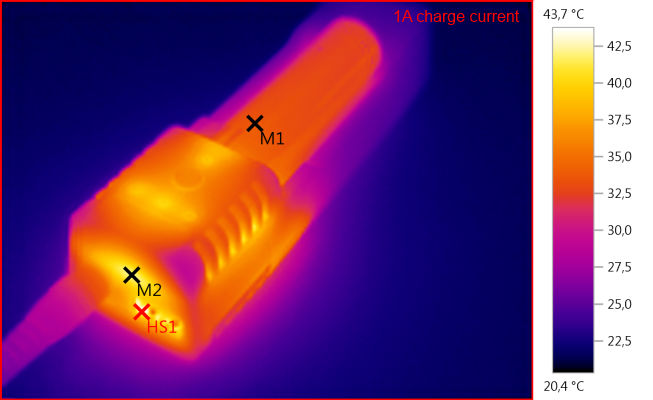
M1: 33,6°C, M2: 42,1°C, HS1: 43,7°C
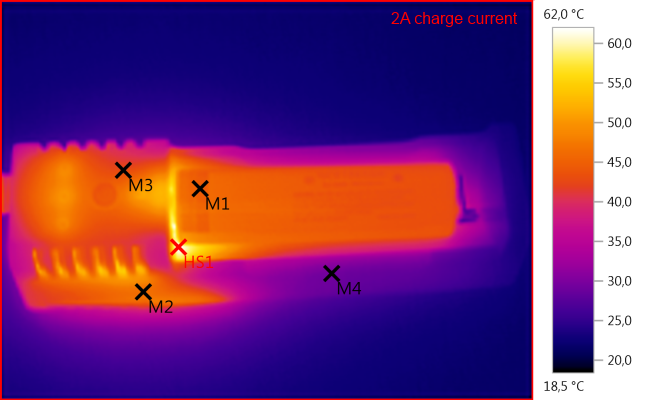
M1: 44,7°C, M2: 46,4°C, M3: 42,9°C, M4: 29,3°C, HS1: 62,0°C
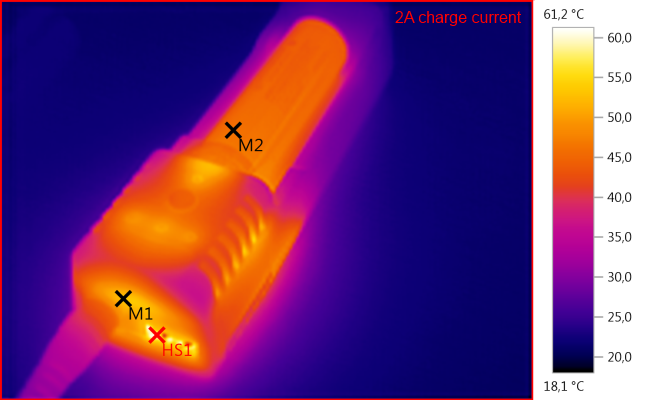
M1: 52,8°C, M2: 46,3°C, HS1: 61,2°C
At 2A the charger get rather warm. This could have been better, but is probably very difficult do improve without a fan or a larger box.
Some of the heat in the battery is probably the battery heating due to the 2A charge current.
3.8V setting LiCoO2, i.e. 4.35 volt charging voltage
There is only a few of these batteries on the market. The higher voltage is an advantage in many single cell flashlights.
.png)
The charger does a perfect CC/CV charge curve. The 4.35 volt is slightly low on my copy of the charger (It is within allowable tolerances), but this also means the voltage is within tolerances to charge a 4.30 volt cell.
Before using the charger for a 4.30 volt cell I will strongly advice to check the charge voltage with a DMM: Connect a DMM parallel to the battery and check that the voltage stays below 4.35 volt all the time while charging
3.2V setting LiFePO4, i.e. 3.6 volt charging voltage
These batteries has lower capacity and lower voltage than LiCoO2 batteries, but the chemistry is safer and the batteries can often deliver large currents.
This setting is also used for LiIon batteries marked 3 volt (See my article about rechargeable CR123 batteries).
.png)
Nice CC/CV charge curve.
.png)
This battery started at a lower voltage and the charger uses a low current to increase the voltage. At 2.9 volt regular charge current will be used.

The charger needs about 4 seconds to start up.
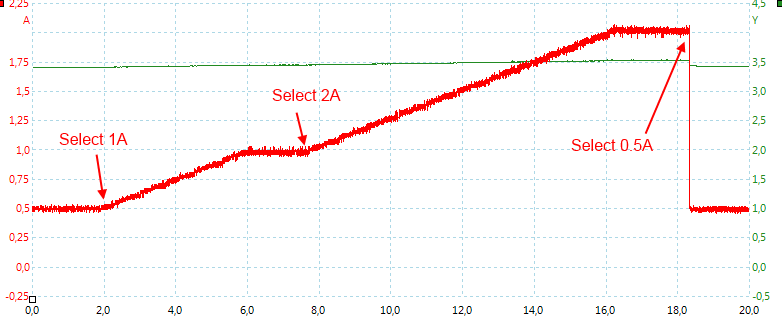
Current selection will increase current slowly and drop current fast.
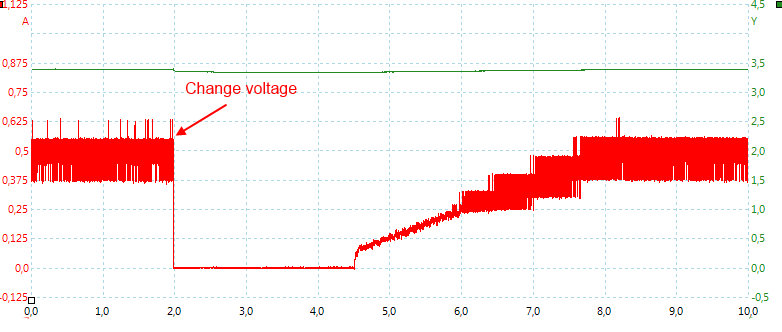
Voltage change will stop charging and the slowly turn up the current again to the selected level.
Measurements on usb power
- The usb output cannot be activated when 12V is supplied to the charger.
- Usb output does not turn on or off automatically, but requires a button press for both.
- With usb output activated the charge will draw up to 35mA from the battery.
- It will draw up to 9mA from the battery when off, i.e. do not leave it with a battery in for weeks.
- At 3.5 volt the usb led will change from green to red, if the voltage raises again it will stay red.
- At 3.17 volt the usb led will start flashing red, if the voltage raises again it will continue flashing.
- When the usb output is turned off due to low battery it cannot be turned on again, before the battery has been replaced.
- Output is coded as Apple 1A.
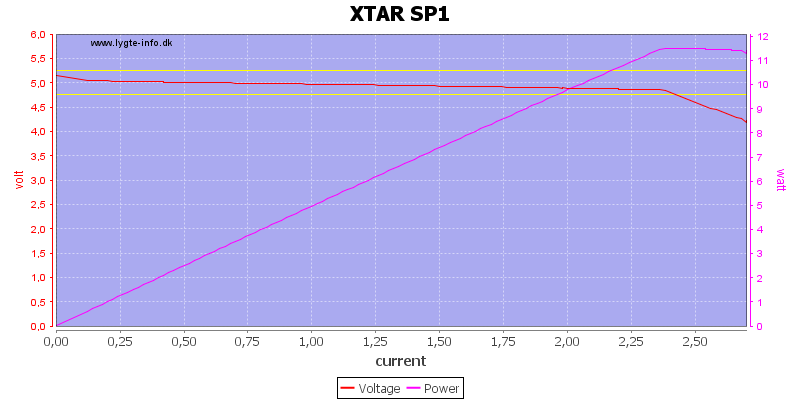
The usb output is rated at 1A, but can deliver much more. I would have preferred a overload cutout.
The output is limited to about 11W, but that is more than twice the rated current.
.png)
Output at 1A looks very nice and with good efficiency.
.png)
.png)
.png)
At 0.5A the efficiency is even higher.
.png)
I did also try with a 4.35 volt cell.

The usb output has very low noise, even at maximum load (9mV rms).

Reducing the load will also reduce the noise, at 0.5A it is down to 7mV rms.
Testing with 2500 volt and 5000 volt between mains and low volt side on power supply, did not show any safety problems.
Conclusion
This charger is a very good charger, it always uses a good CC/CV charging and can handle most LiIon battery sizes and types.
The usb output does also works fine, except the missing over load protection and like all chargers with usb output you must remove the battery when not using the usb output (Within a few days).
Could I wish for more in this charger? The answer is yes, I would have liked a 0.25A setting and maybe even a 0.1A setting. I would also have preferred that the voltage switch was on top of the charger where it is more visible (The led indication does help).
Notes
The charger was supplied by XTAR for a review.
Here is an explanation on how I did the above charge curves: How do I test a charger






















.png)
.png)
.png)
.png)
.png)
.png)
.png)
.png)
.png)
.png)
.png)




.png)
.png)
.png)




.png)
.png)
.png)
.png)
.png)

